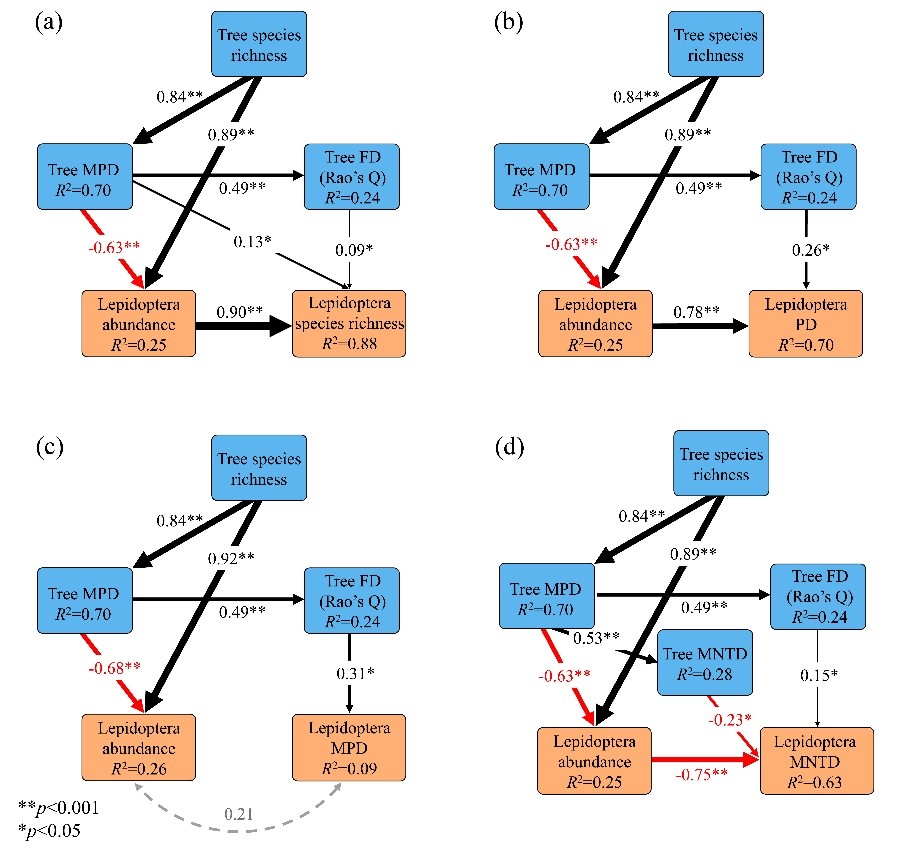Global change leads to increasing biodiversity loss, usually with consequences for the structure and functioning of ecosystems, such as primary productivity and nutrient cycling. Addressing biodiversity loss is a key scientific and societal challenge. Previous work has emphasized the strong linkages between the loss of plant species richness and declines in consumer abundance and diversity. However, the mechanisms underlying these linkages are still unclear.
The joint team from Institute of Zoology, Chinese Academy of Sciences (CAS), University of G?ttingen and Institute of Botany, CAS integrate multiple components of plant and herbivore diversity, with a particular focus on phylogenetic diversity, to identify the linkages that drive biodiversity relationships and determine the consequences of biodiversity loss across different trophic levels. The analyses are based on the largest tree diversity experiment in the world at present and make use of an extensive data set that covers herbivore phylogenetic diversity – a diversity component that so far was rarely available for larger-scale analyses of plant-herbivore interactions.
The study shows that lepidopteran phylogenetic diversity is significantly affected by plant species loss, but only when basic splits in the evolutionary history are considered. Moreover, using structural equation modeling, the results suggest that multiple components of tree diversity can synergistically affect species richness and phylogenetic diversity of lepidopteran larvae. Importantly, plant diversity effects were indirectly mediated by herbivore abundance—which sheds light on the consequences of recently observed declines in the number of insects for the structuring and functioning of ecosystems, including evolutionary dependencies between plants and their herbivore communities.
This work was published online in Journal of Ecology on 20th, August, 2019, as a research article entitled “Multiple components of plant diversity loss determine herbivore phylogenetic diversity in a subtropical forest experiment”. This work was supported by the Strategic Priority Research Program of the Chinese Academy of Science (XDB310304), the National Science Fund for Distinguished Young Scholars (31625024), CAS President's International Fellowship Initiative and other programs to Zhu’s Lab.

Fig. 1. Relationships between tree species richness and (a) abundance of lepidopteran larvae, (b) species richness of lepidopteran larvae, and (c) esitimation of species diversity (q = 0: estimated species richness; q = 1: Shannon diversity; q = 2: Simpson diversity).

Fig. 2. Relationships between tree species richness and (a) Faith’s phylogenetic diversity (PD) and (b) phylogenetic mean pairwise distance (MPD) of lepidopteran larvae. (c) Relationship between phylogenetic mean nearest taxon distance (MNTD) of trees and lepidopteran larvae

Fig. 3. Path model of trees effects of species richness, phylogenetic diversity (MPD) and functional diversity (FD) (blue color) on abundance of lepidopteran larvae and (a) species richness, and (b) Faith’s phylogenetic diversity (PD), and (c) phylogenetic mean pairwise distance (MPD), and (d) mean nearest taxon distance (MNTD) of lepidopteran larvae (orange color).



